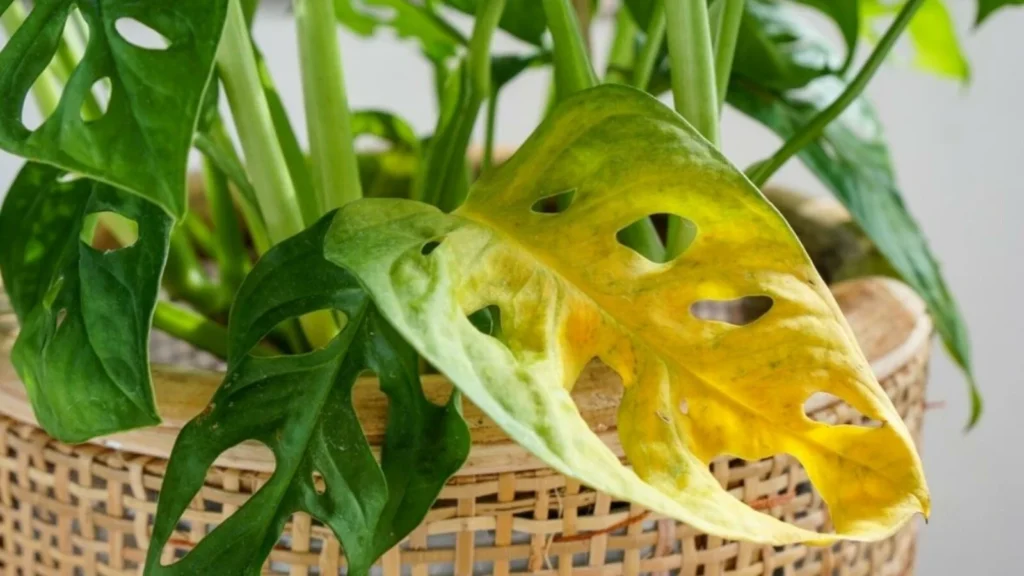Monsteras, with their stunning split leaves, are beloved houseplants that can transform any space into a lush, tropical retreat. However, a wilting Monstera can be a cause for concern. If your plant is looking droopy or unhealthy, don’t worry—many common problems have straightforward solutions. Here’s a guide to identifying the issues and reviving your Monstera to its former glory.
1. Check Your Watering Routine

Watering issues are the most common reason for a wilting Monstera. Both overwatering and underwatering can cause the plant to droop and lose vitality.
Overwatering Symptoms:
- Yellowing leaves
- Mushy stems
- Foul-smelling soil
Underwatering Symptoms:
- Dry, crispy leaves
- Soil pulling away from the pot edges
- Drooping leaves
Solution:
- Overwatering: Allow the soil to dry out completely before the next watering. Repot the plant in fresh, well-draining soil if root rot is suspected.
- Underwatering: Gradually rehydrate the plant by soaking the soil until water drains out the bottom. Avoid flooding it all at once to prevent shock.
2. Assess Light Conditions
Monsteras need bright, indirect light to thrive. Too much direct sunlight can scorch the leaves, while too little light can lead to drooping and yellowing.
Signs of Light Problems:
- Scorched patches or browning on leaves (too much light)
- Slow growth and pale leaves (too little light)
Solution:
Move your Monstera to a spot with bright, indirect light. Use sheer curtains to filter intense sunlight or place the plant near a north- or east-facing window.
3. Inspect for Root Rot
Root rot occurs when the roots sit in waterlogged soil for too long, leading to decay. This condition prevents the plant from absorbing nutrients and water, causing wilting.
Symptoms:
- Dark, mushy roots
- Unpleasant smell from the soil
- Droopy leaves despite regular watering
Solution:
- Remove the plant from its pot and inspect the roots.
- Trim away all blackened or mushy roots using sterilized scissors.
- Repot the plant in fresh, well-draining soil and a pot with drainage holes.
- Water sparingly until the plant recovers.

4. Ensure Proper Humidity
Monsteras thrive in high humidity levels. Dry air can cause leaf edges to curl and droop.
Symptoms of Low Humidity:
- Browning or crispy leaf edges
- Droopy, lifeless leaves
Solution:
- Use a humidifier to maintain humidity levels between 60-70%.
- Group your Monstera with other plants to create a microclimate.
- Mist the leaves regularly or place a pebble tray with water near the plant.
5. Look for Pests
Pests such as spider mites, mealybugs, and scale can sap the plant’s nutrients, leading to wilting.
Symptoms:
- Tiny webs, sticky residue, or white cottony spots on leaves
- Yellowing or curling leaves
- General decline in plant health
Solution:
- Wipe down the leaves with a mixture of water and insecticidal soap.
- Use neem oil as a natural pest deterrent.
- Quarantine the plant to prevent pests from spreading to other plants.
6. Address Nutrient Deficiencies
A lack of essential nutrients can cause your Monstera to look unhealthy and droopy. Over time, nutrient-poor soil fails to sustain healthy growth.
Symptoms:
- Pale or yellowing leaves
- Stunted growth
- Leaf drop
Solution:
Feed your Monstera with a balanced liquid fertilizer every 4-6 weeks during the growing season. Be careful not to over-fertilize, as this can lead to salt buildup in the soil.
7. Consider Temperature Fluctuations
Monsteras are sensitive to sudden changes in temperature. Exposure to drafts, heating vents, or cold temperatures can stress the plant, causing wilting.
Symptoms:
- Drooping leaves
- Browning tips
- General stress signs
Solution:
Keep your Monstera in a stable environment with temperatures between 65-85°F (18-29°C). Avoid placing it near drafty windows, doors, or HVAC systems.
8. Check the Pot Size
If your Monstera is root-bound, it can struggle to absorb water and nutrients, leading to wilting.
Symptoms:
- Roots poking out of drainage holes
- Slow growth
- Drooping leaves despite adequate care
Solution:
Repot your Monstera into a pot that’s 1-2 inches larger in diameter. Refresh the soil and ensure the new pot has proper drainage.
9. Revive Shocked Plants
If you recently moved or repotted your Monstera, it may experience transplant shock, leading to temporary wilting.
Symptoms:
- Sudden drooping after repotting or relocation
Solution:
- Give your plant time to adjust to its new environment.
- Maintain consistent care with proper watering, lighting, and humidity.
- Avoid making additional changes until the plant stabilizes.
10. Regularly Clean the Leaves
Dirty or dusty leaves can hinder your Monstera’s ability to photosynthesize effectively, leading to a lack of energy and eventual wilting.
Solution:
- Wipe the leaves with a damp cloth to remove dust and debris.
- Clean the leaves every few weeks to ensure optimal health and appearance.
Final Thoughts
A wilting Monstera is often a cry for help, but with careful observation and the right interventions, you can restore it to health. By addressing common issues like watering, light, humidity, and pests, your Monstera will reward you with vibrant, lush foliage. Remember, patience is key—plants take time to recover, but the results are always worth the effort!
